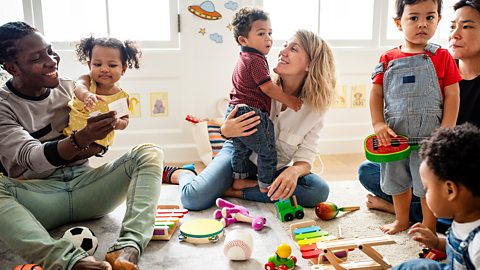When children learn to talk, their ability to pronounce different sounds develops gradually.
They cannot say all their sounds straight away and some take longer to develop than others.
For parents, however, it can sometimes be difficult to know whether your childãs speech sound mistakes are a cause for concern or a normal part of their development.
We asked speech and language therapists, Janet Cooper and Monal Gajjar, to answer some of your most common questions about speech sound development. The answers are below.

Why do children struggle with pronouncing words?
Speech development goes through several phases, just like any aspect of development.
If you think about walking, we do not just get up at birth and walk competently, we need to learn lots of different movements first, and we need lots of practice.
Speech is similar in that it relies on lots of muscles and coordinating their movements (as well as knowing what you want to say and having a range of words to use).
Speaking involves using your breathing muscles, voice box, tongue, teeth, jaw, lips, palate and nose.
Most children find sounds at the front of the mouth the easiest to say- like 'p', 'b', and 'm'. This is because you can see these sounds and copy from other people. Also, lips have good sensory feedback making it easier for children to feel these sounds.
You might find that your childãs first words start with these lips together sounds. These might be followed by sounds using the front of the tongue like 's','t','d','z','n'.
Sounds that are further back in the mouth (like 'k' and 'g') or harder to see (like 'j' and 'ch') might develop much later. Most children will develop the 'r' and 'th' sounds later.
Good speech development relies on good listening skills. The more you hear words spoken to you, the more likely you are to pick up sounds.
Children also need lots of time to practise talking, so they learn to coordinate sounds. Make sure you take lots of time together to talk and listen.
Some words can be tricky and require children to make sounds in with a number of mouth positions. For example, words like ãcarpetã or ãtigerã require both the front and back of the mouth. These words can be difficult to sequence correctly when you first start talking.
The more different mouth positions needed and the more syllables, the harder the word is to say.
If your child doesnãt get it right at first, donãt worry and keep encouraging them to keep talking.
A useful tip would be to repeat the word correctly in a positive way, without correcting them or asking them to repeat back what they think they have already said perfectly!
So if your child says ãpishã for ãfishã, be positive but model it back: 'Yes, itãs a fish.'
Make sure you are at their eye level when you say the words so they can see your lip and mouth movements as you talk.
For older children who struggle with sounds, try clapping or tapping out the syllables of longer words to help them become aware of the different sounds in a word.
Itãs ok if they say the sounds incorrectly. Keep modelling and praising all their attempts!
Can I pass on my pronunciation problems to my child?
Children develop their speech sounds through a combination of listening, storing what they hear and then moving their muscles in the correct place to make sound.
They pick this up from the world around them - family, friends, siblings, nursery and even TV.
Parents have a huge influence on this as they are often the ones who spend the most time with their children. However, as speech develops, children are constantly ãfine tuningã their own speech to adapt to what they hear around them. So if one parent has mild speech difficulties, the child is unlikely to copy this if they are also accessing other family members and interacting more widely.
Some more severe speech disorders are inherited, so if you have a speech sound disorder and your child is struggling with speech development then you may need to seek help from a Speech and Language Therapist.
Why do most children struggle to sound out ãsã?
To make an 's' sound, you need to coordinate where your tongue is placed (at the front of your mouth up behind your top teeth), spread your lips and control the air stream coming out all at once.
This is much tricker than just putting your lips together to make a 'p', 'b', or 'm' sound.
When children learn this sound, they might substitute a 'd' sound, which is made with the same tongue position but without the air stream.
This is very common.
Over time and with practice, this should eventually turn into the 's'. You can help by using the 's' sound in play and giving lots of opportunities for your child to practise it. For example, use a toy snake saying 'sssss' as it slithers along.
How do I help my child with the ãlã sound?
wadder instead of ladder
The sound ãlã is often quite a late sound in normal speech development and some children donãt get this until they are around 4 years old - often substituting it for a ãwã sound.
When they are younger, donãt draw attention to the way they are pronouncing it but encourage lots of listening games to help your child tune into your speech.
These could be ãwhat am I?ã games, listening walks and rhyming snap. All are good for fine-tuning listening for speech.
You may want to emphasise the way you are saying the words so that your child can see that the front of your tongue lifts up too. If everything else is developing well it is likely this will come in time, especially when they start to learn phonics at school.
What to do when child pronounces ãsã sound at the back of the throat?
Make sure you have got rid of dummies and bottles as they can often encourage the tongue to overdevelop the sounds at the back of the mouth.
Try some tongue copying games in the mirror. Can they copy you and put their tongue up to their nose? Down to their chin? Side to side? Have fun making funny faces and see if they can copy.
If they can then try a ãtã sound very quietly and repeat it really fast t,t,t,t- this puts the tongue in the right position to say an ãsã sound.
This might help them imitate the ãsã from this point.
Replacing ãfã and ãvã with ãbã or ãsã and ãzã with ãt ãand ãdã
binger instead of finger / tock instead of sock, doo instead of zoo
This is a speech sound process known as stopping, which is quite a usual process for children up until around the age of 3.
If your child can say the sound on its own, then try doing some sound play with words beginning with it eg ãfã, such as ãfee, fi, fo, fumã from Jack in the Beanstalk. This might help your child gradually be able to say words beginning with ãfã.
Itãll take some practice, and lots of encouragement, for them to change how they say words on their own to start off with.
Find some pictures of words beginning with ãfã, and make them into flashcards, so you can play hide and seek with the cards, to keep the practice fun. Then you can work towards saying short sentences with the words.
Why do kids replace ãrã sounds for ãwã?
wabbit instead rabbit
This is a speech sound process known as gliding. ãRã is a tricky sound for little children, and is often learnt around age 5 plus.
We canãt see the tongue very well for this sound so children often struggle to imitate it. If your child is younger, you can help them by keeping sound play fun.
Try introducing them to a ãracing car noiseã ã ãrrrrrrrã. Practice doing that until theyãve definitely got it, then see if they can copy you saying 'rrrrrrrrrrrace!'
Give them time, because it may be that theyãre just not quite ready yet.
ãRãs at the beginning of very short words will be the easiest ones to change first.
Saying ãfã instead of ãthã
free instead of three
Substituting 'f' for 'th' is a really common developmental phase. It's sometimes part of an accent too.
Speech therapists are generally not worried about this until children are over 6 years old.
Try modelling lots of words beginning with the 'th' sounds but don't put any pressure on your child to say them. It should come in time.
Missing the last sound of words
ha instead of hat
This is a process, known as final consonant deletion that can be very normal up until around 3 years old.
Children often miss the ends of words as they start talking. The more practise they have at talking the better they will get at pronouncing the words more clearly.
Encourage word endings through lots of listening to songs, rhymes and talking.
It is also a good idea, however, to get a hearing test for your little one to rule out anything else.
What age does phonological awareness develop?
Phonological awareness is recognising all of the elements that make up the sound, like rhyme, recognising initial sounds and how many beats a word is made up of.
These are essential skills for early reading and they start from birth. The early skills are when the child tunes into a word that you are saying and they try to imitate back.
The best way to develop this is through lots of talking together, reading to your child and singing!
When your child is around 4-years-old, playing rhyming games together can really help develop this phonological awareness.
Additional help
If you're worried about your child's speech and language progress, has lots of advice and resources for parents.
If you are following all of these bits of advice and your child is still not progressing, you may need a referral to a speech and language therapist.
Most speech and language therapy departments can be accessed via your local NHS service. You can often make the referral yourself, but it is always good to check first with your childãs health professional, GP or nursery practitioner.






